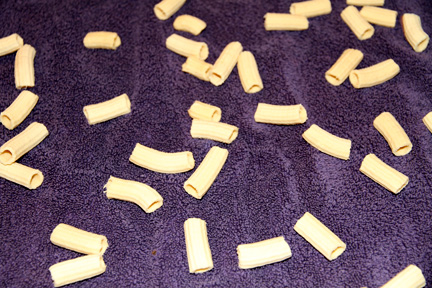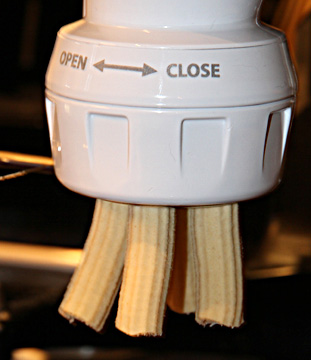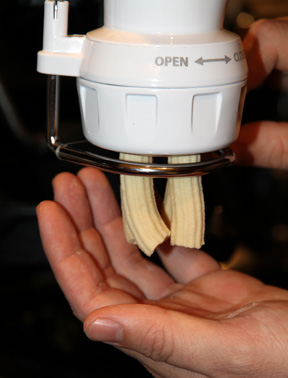So, for my birthday, my partner got me the KitchenAid attachment that extrudes pasta. (Their more popular, slightly cheaper pasta attachment is a roller and cutter, which allows you to make authentic fettucini, lasagne, etc.) With the extruder you can made REAL spaghetti (the roller makes square “spaghetti”), macaroni, fusilli (kinda like rotini but less twisty), rigatoni, and bucatini (which is like thick spaghetti, but hollow in the center like macaroni). I jumped up and down! I love making homemade pasta, but I have a hand roller machine, and it’s kind of a pain. On MasterChef I used the KitchenAid roller attachment, which I’ll admit was slightly better, because you can use both hands to handle the pasta…but rolled pasta is still notoriously difficult to handle, especially the thinner cuts. It clumps together unless you absolutely douse it in flour, and when you then boil the floury pasta, you get TERRIBLE boil-overs.
I was REALLY excited to try it, but I’ll admit…it’s a plastic machine that costs around $160, and I doubted its ability to ACTUALLY extrude quality pasta. (A genuine pasta extruding machine costs thousands of dollars.) A LOT of pressure is required to force pasta dough through tiny dies, which are normally made of bronze, and the KitchenAid’s dies are made of plastic and chrome. So the first time I used it, I was skeptical and didn’t expect miracles.
I threw together a simple pasta dough…1 cup of AP flour, 1 cup of cake flour, and 1 cup of semolina (what true Italian pasta is made of), 3 eggs, salt, and a splash of water. I let my KitchenAid do the first part of the kneading…I took over for the last minute to get it really smooth. Without letting the pasta rest (essential if you’re rolling it out, to let the gluten relax so the dough doesn’t tear), I immediately put a walnut-sized ball of dough into the extruder. After about a 30 second wait, while the dough was corkscrewed down and pressed through the dies, here’s what came out:
Uhhhh…wow! That’s some rigatoni, baby!
I could NOT believe my eyes. This was a stiff dough…1/3 semolina. And here comes perfect rigatoni!
There is a built-in slicer that quickly cuts the pasta off, and you just catch it in your hand and toss it onto a towel to dry.

I continued feeding walnut-sized pieces into the extruder, making sure the dough fully disappeared into the corkscrew before adding more. (Per the directions on the package.) About 30 minutes after I started making the dough, I had 2 pounds of fresh rigatoni drying on the towel on my countertop.
I let it dry for about an hour, then tossed it into a 6 quart Dutch oven about 2/3 full of boiling water. Like rolled pasta, there was quite a bit of foaming, due to the gluten fibers in the flour escaping into the water and forming a “skin” that causes the water to foam and boil over…but it wasn’t NEARLY as bad as rolled pasta. (I actually didn’t have any water boil over at all, but the foam rose to within 1/2 inch of the pot’s rim.)
By the way, when you’re boiling pasta, your water should be SALTY. Not a teaspoon or a tablespoon. A handful. Italian chefs say the pasta boil water should taste as salty as the ocean. If not, your pasta won’t taste its best.
I boiled the fresh rigatoni (after it dried for an hour) for 3 minutes. ThenI finished cooking it about a minute longer in a vodka sauce I tossed together quickly. If the rigatoni had gone straight from the extruder into the water, it probably only needed 2 minutes.
MAN was it good! This machine is really impressive, I NEVER would have imagined it would be so effective. (And I have NO relationship with KitchenAid whatsoever…this is a genuine, non-biased review.)
Rigatoni being extruded from the Kitchenaid pasta attachment
Cleanup is a little perplexing, as it is with ALL pasta machines. NO water! You have to disassemble the extruder (as easy as unscrewing the lid), pop out the die, and pop out the plastic corkscrew that presses the pasta. Then let it sit overnight for the dough to dry, then you pick out the dried dough with the tip of a knife. There is a brush included with the set that you can use to brush everything off, then put it back in the box. NO washing, this will ruin the unit.
Today I tried a dough that was 50% AP flour, and 50% semolina, which is much stiffer and more authentic, but I assumed the extruder would have a harder time with it. I also chose to extrude fusilli, which is more difficult to extrude than rigatoni, to REALLY give this machine a workout.
Flawless performance. (No pictures, sorry, my hands were full and Christian was at work.) It took me 15 minutes, start to finish, to make the dough and extrude it, 2 minutes in the boil water, and 1 minute in the sauce. Compare that with the length of time you have to boil storebought dried pasta, and it’s ALMOST the same amount of time to get pasta on the plate…only this is fresh and homemade!
Needless to say, I’m going to be making homemade pasta WAY more frequently now. None of the mess of rolled pasta. And it’s so great to take the dough straight from kneading into the extruder, without having to let the gluten rest. You could literally have surprise guests show up on your doorstep, jump into the kitchen, and have a full homemade pasta meal in 30 minutes. Extraordinary.
I should footnote here that I am using the KitchenAid Professional 600 (575 watts), not the more popular Artisan model, which has 325 watts. I’m not sure if the smaller amount of power will have an effect on performance.
At around $160-$180 retail, this is NOT an attachment for penny pinchers. Of course, if you have a Kitchenaid, you are probably not a penny pincher. I am NOTORIOUSLY stingy with my money, and was given my KitchenAid Pro as a gift for planning a friend’s wedding, and I can WITHOUT A DOUBT say that it’s worth every single penny of the $350ish dollars it costs, and had I known it was going to change my kitchen life, I’d have bought it with my own money many years ago.
Would I have gone out and spent $160 on this attachment? No. Because I’m a stingy jerk. But now that I’ve used it, and see how incomparably easy it is to make extruded pasta, I will get my money’s worth very quickly. I give this attachment 10 out of 10…I’m THAT impressed!


Leave a Reply
You must be logged in to post a comment.